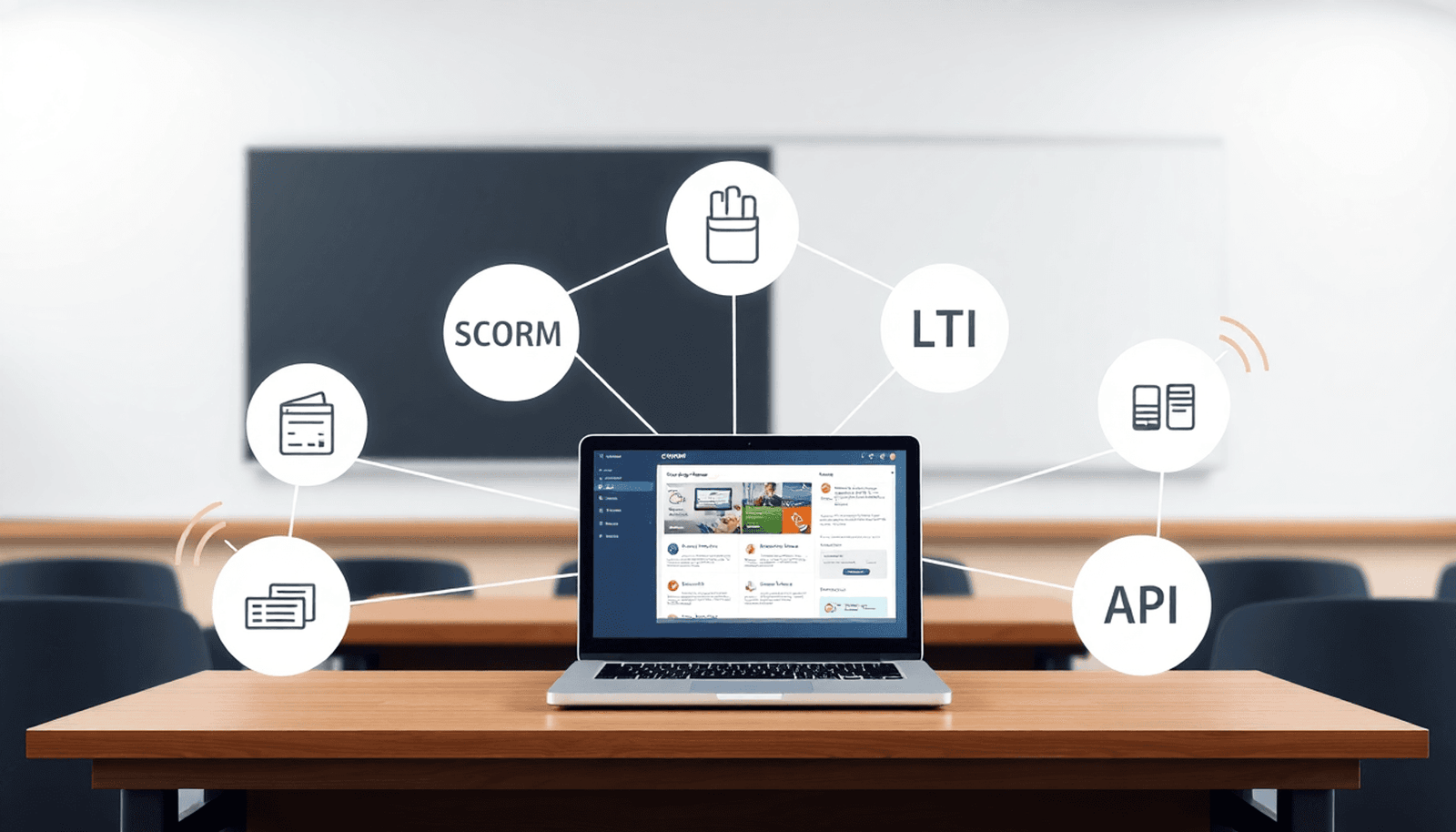- SCORM, LTI, API—What You Really Need to Know
In the realm of eLearning, SCORM, LTI, and API stand as pillars of digital learning technology. These standards play a pivotal role in ensuring seamless interoperability and effectiveness within educational platforms. Understanding the intricacies of SCORM, LTI, and API is not just beneficial but essential for anyone engaged in digital learning endeavors. Embracing these technologies empowers educators, entrepreneurs, and content creators to harness the full potential of eLearning tools and resources. Stay tuned to unravel the significance of SCORM, LTI, and API in revolutionizing the landscape of online education.
Understanding SCORM, LTI, and API Standards in eLearning
When exploring SCORM, LTI, and API in the world of eLearning, it's important to understand that these standards are crucial for creating, sharing, and tracking digital learning content. Each of them has a unique role that complements the others in improving the experience for both users and administrators.
The Roles of SCORM, LTI, and API
Here's a breakdown of what each standard does:
- SCORM (Sharable Content Object Reference Model): This standard defines how eLearning content should be packaged and launched. It ensures that courses made on one platform can be played on another without any compatibility problems. This consistency makes it easier to deliver content across different Learning Management Systems (LMS).
- LTI (Learning Tools Interoperability): This standard focuses on integrating external learning tools and applications directly into LMS environments. It allows seamless access to third-party resources with features like single sign-on (SSO), removing barriers between different platforms and simplifying user authentication.
- API (Application Programming Interface): In the context of eLearning, APIs enable systems to communicate with each other and share data beyond just delivering courses. A modern example is xAPI (Experience API), which tracks various learner activities across multiple devices and platforms—far more than what traditional SCORM tracking can do.
How These Standards Work Together
The combination of these standards promotes interoperability—the ability of different systems to work together smoothly—and enhances the effectiveness of digital learning solutions by:
- Allowing content reuse without redevelopment
- Simplifying integration of new tools or resources
- Improving detailed tracking and analytics for personalized learning paths
By understanding these three key components, you can make better choices when developing or choosing eLearning solutions that are flexible, scalable, and ready for the future. This knowledge is vital if you want your educational offerings to perform well across various platforms while providing valuable insights into learner data.
1. The Role of SCORM in eLearning Content Packaging
Explaining SCORM
SCORM, which stands for Sharable Content Object Reference Model, is a set of standards that allows eLearning content to be packaged and delivered across different Learning Management Systems (LMS). It ensures interoperability between content and various LMS platforms.
Different Versions of SCORM
There are two main versions of SCORM - SCORM 1.2 and SCORM 2004. SCORM 1.2 is the most widely used version and focuses on tracking completion status and quiz scores. On the other hand, SCORM 2004 offers more robust tracking capabilities, including sequencing and navigation support.
Tracking Learner Interactions
One of the key roles of SCORM is enabling the tracking of learner interactions within an LMS. This includes monitoring how users engage with content, their progress through courses, quiz results, and other relevant data points. SCORM allows instructors and administrators to assess the effectiveness of learning materials and make data-driven decisions to enhance the learning experience.
By understanding how SCORM works and its importance in eLearning content packaging, educators and content creators can ensure seamless delivery and tracking of educational materials within their chosen LMS platform. This understanding can also assist in implementing strategies like Results-Based Management to enhance performance accountability or developing an Employee Attendance System for better tracking of learners' participation.
2. Seamless Integration with LTI for External Learning Tools
LTI, or Learning Tools Interoperability, is a standard developed by the IMS Global Consortium to simplify the integration of third-party learning applications into Learning Management Systems (LMS). Unlike SCORM, which focuses on packaging and tracking course content within the LMS, LTI provides a framework that allows external tools and resources—such as quizzes, simulations, or collaborative platforms—to connect seamlessly with an LMS environment.
The core purpose of LTI is to enable these external learning tools to launch from within the LMS without requiring separate logins or manual configurations. This capability dramatically improves the user experience by offering:
- Single sign-on (SSO): Learners access diverse educational tools using their existing LMS credentials, eliminating multiple password challenges.
- Smooth data exchange: LTI handles communication between the LMS and external applications, allowing for sharing learner information, grades, and activity results automatically.
- Reduced development overhead: Since LTI is a standardized protocol, educators and developers avoid building custom integrations for each external tool they want to incorporate.
LTI versions have evolved over time. LTI 1.x introduced basic launch capabilities between LMS and tools. LTI Advantage builds on this by adding enhanced security features, deeper grade sync options, and richer context sharing. This evolution reflects growing demand for more robust interoperability in complex eLearning ecosystems.
Comparing SCORM and LTI shows distinct roles:
- SCORM handles content packaging inside an LMS with detailed interaction tracking.
- LTI focuses on integration of external applications into the LMS environment while maintaining consistent user experience.
APIs can complement both standards but operate at a more flexible level to enable broader data exchange scenarios beyond what SCORM or LTI cover.
Using LTI means you can quickly add powerful new features to your courses without reinventing the wheel or disrupting your learners' workflow. For educators and content creators seeking modularity and expansion possibilities in their digital learning environments, understanding how LTI functions alongside SCORM and APIs is essential.
3. Unlocking Advanced Tracking and Flexibility with APIs in eLearning
APIs, or Application Programming Interfaces, are tools that allow different software programs to work together. In eLearning, APIs do more than just deliver content and track progress; they open up new ways to collect detailed information about learners and integrate with other systems.
Understanding xAPI: A Game-Changer for Tracking Learning
One of the most significant examples of an API in eLearning is xAPI, also known as the Tin Can API. Unlike older standards like SCORM that only track activities within a Learning Management System (LMS), xAPI has a broader scope.
What does xAPI track?
With xAPI, you can capture learning experiences from various sources:
- Mobile apps
- Simulations
- Virtual reality environments
- Offline learning activities
This flexibility allows you to gather insights into learner behaviors, preferences, and progress regardless of where or how learning takes place.
The Benefits of Using APIs like xAPI in eLearning
Here are some key advantages of incorporating APIs such as xAPI into your eLearning strategy:
- Cross-platform compatibility: Track learning data across multiple devices including desktops, smartphones, tablets, and emerging technologies without being tied to a specific LMS.
- Detailed data capture: Record complex interactions such as problem-solving steps, social learning activities, or informal knowledge sharing.
- Flexibility in reporting: Extract custom reports and analytics tailored to your organization’s unique goals rather than relying solely on pre-built LMS dashboards.
- Integration with other systems: Connect learning data with HR platforms, CRM tools, or business intelligence software for a comprehensive view of performance and development.
Empowering Educators and Content Creators through Flexibility
APIs provide educators and content creators with a versatile framework that adapts as digital learning evolves. This flexibility supports personalized learning paths and continuous improvement based on real-time evidence rather than static completion metrics.
By embracing APIs like xAPI, you position your digital learning environment to capture the full spectrum of learner activity—not just isolated course completions but the entire journey across devices and contexts.
Choosing the Right Technology: A Comparison of SCORM, LTI, and API Standards for Your Needs
When it comes to selecting the appropriate technology for your eLearning projects, understanding the differences between SCORM, LTI, and API standards is crucial. Each of these technologies has its own unique features and benefits that can greatly impact the effectiveness of your digital learning experiences.
1. SCORM (Sharable Content Object Reference Model)
Key Features:
- Enables content packaging and tracking within Learning Management Systems (LMS).
- Standardizes how online learning content is created and delivered.
- Supports interoperability between different eLearning systems.
Benefits:
- Ensures consistent user experience across various platforms.
- Facilitates content reuse and repurposing in different courses.
- Tracks learner progress and interactions for assessment purposes.
2. LTI (Learning Tools Interoperability)
Key Features:
- Streamlines integration of external learning tools into LMS platforms.
- Allows for Single Sign-On (SSO) capabilities for seamless user experience.
- Promotes data exchange between different systems without custom coding.
Benefits:
- Reduces development time for incorporating third-party tools.
- Enhances user engagement by providing a unified learning environment.
- Simplifies access management and user authentication processes.
3. API (Application Programming Interface)
Key Features:
- Provides flexibility for cross-platform tracking of learning experiences.
- Enables detailed data collection beyond traditional LMS capabilities.
- Supports integration with various devices and applications.
Benefits:
- Offers advanced analytics for monitoring learner performance.
- Allows for personalized learning experiences based on collected data.
- Enhances scalability and adaptability of eLearning solutions.
By understanding the distinct features and benefits of SCORM, LTI, and APIs, you can make informed decisions when selecting technologies that best suit your specific eLearning requirements. Each standard plays a crucial role in enhancing the effectiveness and efficiency of digital learning experiences, catering to diverse needs in educational or entrepreneurial projects.
Practical Applications with Uthena’s Whitelabel PLR Video Courses
Keywords: "Uthena courses, whitelabel PLR courses, SCORM, LTI, API—What You Really Need to Know"
Talking points:
- Uthena, a platform specializing in whitelabel PLR video courses, exemplifies the effective utilization of SCORM, LTI, and APIs in digital learning.
- Uthena's courses are not only high-quality but also customizable and resellable due to the implementation of these standards.
- By leveraging SCORM for content packaging and tracking, LTI for seamless tool integration and single sign-on capabilities, and APIs for flexible cross-platform tracking, Uthena ensures an enriched learning experience for its users.
By incorporating these standards into their platform, Uthena empowers entrepreneurs, educators, and content creators with ready-made professional-grade courses that can be tailored to individual needs through branding, reselling, and customization options.
Future Trends in eLearning Standards and Integration
The future of eLearning standards is evolving rapidly, driven by the need for richer data, seamless integrations, and more adaptive learning experiences. Several key trends stand out:
-
SCORM Updates and Alternatives
While SCORM has been a foundational standard, its limitations have led to emerging alternatives that address modern learning environments. Newer specifications aim to improve flexibility and compatibility with mobile and offline learning scenarios. These developments focus on enhancing content packaging without compromising interoperability. -
Growing Importance of APIs like xAPI
xAPI (Experience API) is gaining traction as a powerful tool for capturing detailed learner interactions beyond traditional LMS boundaries. It tracks activities across multiple platforms and devices, providing granular insights into learner behavior. This depth of data supports personalized learning paths and advanced analytics, which are becoming essential for effective eLearning strategies. -
Increasing Adoption of LTI for Seamless Tool Integrations
LTI continues to expand its role by simplifying the integration of diverse third-party tools into LMS ecosystems. Its ability to support single sign-on (SSO) and secure data exchange reduces development overhead and enhances user experience. As educators and content creators leverage more specialized tools, LTI ensures these resources fit smoothly into existing workflows.
Staying informed about these trends empowers you to select technologies that align with your educational goals or business model. Adapting to advancements in standards like SCORM updates, xAPI capabilities, and LTI integrations helps maintain competitive advantage while delivering more effective digital learning experiences tailored to today’s learners.
Conclusion
Understanding SCORM, LTI, API—What You Really Need to Know is essential when choosing eLearning technology for your projects. Each standard serves a distinct purpose:
- SCORM excels in content packaging and learner interaction tracking within LMS environments.
- LTI simplifies integrating external tools with single sign-on and seamless data exchange.
- API, especially xAPI, unlocks advanced tracking across platforms and devices, capturing rich learning experiences.
You should start by evaluating your specific goals and technical requirements. Are you focused on delivering structured courses with detailed learner progress? SCORM might be the best fit. Need to incorporate third-party apps smoothly? LTI offers an efficient solution. Looking for flexibility in tracking diverse learning activities beyond the LMS? APIs like xAPI provide that capability.
Staying informed on industry trends ensures you don’t miss out on innovations that can elevate your digital learning offerings. Technologies evolve, new standards emerge, and integration capabilities improve constantly. This knowledge empowers educators, entrepreneurs, and content creators to make strategic decisions that lead to long-term success.
Choosing eLearning technology is not just about adopting a tool—it’s about aligning solutions with your educational vision and business model. The right choice today sets the foundation for effective, engaging digital learning tomorrow.
FAQs (Frequently Asked Questions)
What is SCORM and why is it important in eLearning?
SCORM, or Sharable Content Object Reference Model, is a key eLearning standard that packages and delivers digital learning content effectively. It ensures interoperability within Learning Management Systems (LMS) and enables tracking of learner interactions. Different versions like SCORM 1.2 and SCORM 2004 offer varying features to enhance content delivery and learner engagement.
How does LTI facilitate integration of external learning tools in LMS platforms?
LTI, or Learning Tools Interoperability, developed by IMS Global Consortium, allows seamless integration of third-party learning applications into LMS platforms. It provides advantages such as single sign-on (SSO) capabilities and smooth data exchange without requiring custom coding, enhancing the overall digital learning experience.
What role do APIs play in advancing eLearning tracking and flexibility?
APIs, particularly xAPI (Tin Can API), enable detailed tracking of diverse learning experiences beyond traditional LMS capabilities. They support cross-platform and device compatibility, allowing educators to capture complex learner data and provide more flexible, personalized digital learning solutions.
How do SCORM, LTI, and API standards compare in terms of their application in eLearning?
SCORM primarily focuses on content packaging and tracking within LMSs; LTI excels in integrating external tools with features like SSO; while APIs offer flexible, cross-platform tracking of rich learning experiences. Choosing the right standard depends on specific educational or entrepreneurial needs for effective digital learning delivery.
Can you provide an example of how these eLearning standards are applied in real-world scenarios?
Organizations like Uthena leverage SCORM, LTI, and API standards to offer high-quality whitelabel PLR video courses that are customizable and resellable. This practical application demonstrates how these technologies enhance course interoperability, tool integration, and advanced learner tracking.
What are the future trends in eLearning standards such as SCORM, LTI, and APIs?
Emerging developments include updates or alternatives to SCORM to improve content interoperability; increased importance of APIs like xAPI for capturing complex learner data; wider adoption of LTI for seamless tool integrations; staying informed on these trends benefits educators and content creators aiming for long-term success in digital learning.









